Important Influencing and Decision Factors in Organic Food Purchasing in Hungary
Abstract
1. Introduction
2. Literature Review
3. Material and Methods
3.1. Sampling and Survey Instrument
3.2. Data Analysis
4. Results
4.1. Main Characteristics Of Organic Food Consumers
4.2. The Outcomes Of Factor Analysis
5. Discussion and Conclusions
Limitations
Author Contributions
Funding
Acknowledgments
Conflicts of Interest
Appendix A
- How often do you consume the following food categories?0—never, 1—less than once in a month, 2—1–2 times in a month, 3—1–2 times in a week, 4—3–4 times in a week, 5 every day
stock-cube 0 1 2 3 4 5 ice cream 0 1 2 3 4 5 potato chips 0 1 2 3 4 5 beer 0 1 2 3 4 5 sparkling juice 0 1 2 3 4 5 canned fruit 0 1 2 3 4 5 quality wine 0 1 2 3 4 5 confectionery 0 1 2 3 4 5 cold cuts, wiener wurst 0 1 2 3 4 5 margarine 0 1 2 3 4 5 juice 0 1 2 3 4 5 chocolate 0 1 2 3 4 5 fermented cheese 0 1 2 3 4 5 pickles 0 1 2 3 4 5 milk 0 1 2 3 4 5 egg 0 1 2 3 4 5 butter 0 1 2 3 4 5 salami 0 1 2 3 4 5 mineral water 0 1 2 3 4 5 fruits 0 1 2 3 4 5 bakery 0 1 2 3 4 5 vegetables 0 1 2 3 4 5 - How are you affected by the following factors in your food purchase? Please, indicate it with 1–5.1—I am not affected at all, 5—I am affected in a great extent
advertising high-preparedness wrapping high-endurance price habit colour label/certification nutrients recommendation free of E-number brand additives origin components good impact on health taste freshness - What do you think about the health impact of the following articles?1—it is not harmful, 5—very dangerous
animal fat exposing food to smoke salt high energy content high fat content sweetening content allergens trans-fatty acid additives high sugar content mold preservatives GMO content artificial food colouring antibiotic residue pesticide residues hormone residues advertisement wrapping easy to prepare brand long shelf life recommendation color label routine price origin nutrient content free from E-number free from additives ingredients positive impacts to health flavour freshness - Do you buy any food direct from the producer?1—Yes2—NoIf yes, list it, please!
- How often do you use the following supply channels?Please, use the following code!0—never, 1—less than once in a month, 2—1–2 times in a month, 3—1–2 times in a week, 4—3–4 times in a week, 5 every day
local producers’ market organic market directly from producers through the internet traditional market other direct selling form - How often do you buy organic food?0—never, 1—less than once in a month, 2—1–2 times in a month, 3—1–2 times in a week, 4—3–4 times in a week, 5 every day
- Where you usually buy organic food?
organic market directly from producers through the internet special organic food store retail chain other:_________________________ - Are you up-to-date in food-safety issues? Please, indicate it with 1–10. 1—I am totally uninformed, 10—I am very familiar with the topic.
- What is your opinion about the food-safety situation in Hungary? Has it changed in negative or positive direction in the last 10 years? 1—it has been getting worse in a great extent, 2—it has been getting worse, 3—it has not changed, 4—It has improved in some extent, 5—It has improved much
- Are you agree with the following statements? Please, indicate with 1–5!1—I am totally disagree with it, 5—I am totally agree with it.
I trust in food sold by food stores. I found the activity of the authorities adequate. I try to buy food made by small scale farmers. I always read the name of the processor on the label. I can buy safer food on the market. I buy only trusty food. I prefer Hungarian food. I try to purchase healthy food. Most of the food is full of harmful ingredients. I take care of that where I buy food. I think I am a conscious consumer. - What is your gender?[] female[] male
- What is your highest level of education? Please, indicate it![] primary school[] vocational school[] technical college[] grammar school[] college/university
- The age of the respondent:[] under 20 [] between 20 and 30 [] between 31 and 40 [] between 41 and 50 [] between 51 and 65 [] more than 65
- Settlement type of the respondents’ residence:[] Budapest (capital city) [] chief town of a county [] other city [] village [] ranch
- Occupation of the respondent:[] unskilled worker [] skilled worker [] entrepreneur [] employee [] manager [] pensioner [] student
- Net income in your familymuch smaller than the averagesmaller than the averageaveragemore than the averagemuch more than the average
References
- Stoleru, V.; Munteanu, N.; Istrate, A. Perception Towards Organic vs. Conventional Products in Romania. Sustainability 2019, 11, 2394. [Google Scholar] [CrossRef]
- Bosona, T.; Gebresenbet, G. Swedish Consumers’ Perception of Food Quality and Sustainability in Relation to Organic Food Production. Foods 2018, 7, 54. [Google Scholar] [CrossRef] [PubMed]
- Radman, M. Consumer consumption and perception of organic products in Croatia. Br. Food J. 2005, 107, 263–273. [Google Scholar] [CrossRef]
- Petrescu, A.G.; Oncioiu, I.; Petresc, M. Perception of Organic Food Consumption in Romania. Foods 2017, 6, 42. [Google Scholar] [CrossRef]
- Brown, E.; Dury, S.; Holdsworth, M. Motivations of consumers that use local, organic fruit and vegetable box schemes in Central England and Southern France. Appetite 2009, 53, 183–188. [Google Scholar] [CrossRef]
- Oroian, C.F.; Safirescu, C.O.; Harun, R.; Chiciudean, G.O.; Arion, F.H.; Muresan, I.C.; Bordeanu, B.M. Consumers’ Attitudes towards Organic Products and Sustainable Development: A Case Study of Romania. Sustainability 2017, 9, 1559. [Google Scholar] [CrossRef]
- Popa, I.D.; Dabija, D.-C. Developing the Romanian Organic Market: A Producer’s Perspective. Sustainability 2019, 11, 467. [Google Scholar] [CrossRef]
- Lehota, J.; Horváth, Á.; Rácz, G. The effect of sustainability on the information search behaviour of hungarian consumers through the practice of food purchasing. Acta Aliment. 2014, 43, 437–443. [Google Scholar] [CrossRef]
- Nielsen Global Health, & Wellness Survey. We Are What We Eat. 2015. Available online: http://www. nielsen.com/us/ (accessed on 15 December 2016).
- Roman, S.; Sanchez-Siles, L.M.; Siegrist, M. The importance of food naturalness for consumers: Results of a systematic review. Trends Food Sci. Technol. 2017, 67, 44–57. [Google Scholar] [CrossRef]
- GFK Hungary Market Reserarch Ltd.; Agrár Europe Ltd. Both Fruits and Vegetables Are among Most Popular Food Products. 2011. Available online: http://producejournal.com/both-fruits-and-vegetables-are-among-most-popular-food-products (accessed on 27 October 2019).
- Szabó, D. Examination of Farmers’ Markets from Market Organiser, Producer and Consumer Perspective. Ph.D. Thesis, Szent Istvan University, Gödöllő, Hungary, 2017. Available online: http://phd.szie.hu/?docId=15826 (accessed on 27 October 2019).
- Lynch, M.F.; Tauxe, R.V.; Hedberg, C.W. The growing burden of foodborne outbreaks due to contaminated fresh produce: Risks and opportunities. Epidemiol. Infect. 2009, 137, 307–315. [Google Scholar] [CrossRef]
- Strawn, L.K.; Schneider, K.R.; Danyluk, M.D. Microbial Safety of Tropical Fruits. Crit. Rev. Food Sci. Nutr. 2011, 51, 132–145. [Google Scholar] [CrossRef] [PubMed]
- Sivapalasingam, S.; Friedman, C.R.; Cohen, L.; Tauxe, R.V. Fresh Produce: A Growing Cause of Outbreaks of Foodborne Illness in the United States, 1973 through 1997. J. Food Prot. 2004, 67, 2342–2353. [Google Scholar] [CrossRef] [PubMed]
- Food and Agricultural Organization (FAO)/World Health Organization (WHO). Microbiological Hazards in fresh Leafy Vegetables and Herbs; Microbiological Risk Assessment Series; FAO/WHO: Geneva, Switzerland, 2008; Volume 14, pp. 1–163. Available online: http://www.who.int/foodsafety/publications/micro/mra_fruitveges/en/index.html (accessed on 27 October 2019).
- Berger, C.N.; Sodha, S.V.; Shaw, R.K.; Griffin, P.M.; Pink, D.; Hand, P.; Frankel, G. Fresh fruit and vegetables as vehicles for the transmission of human pathogens. Environ. Microbiol. 2010, 12, 2385–2397. [Google Scholar] [CrossRef] [PubMed]
- Van Boxstael, S.; Habib, I.; Jacxsens, L.; De Vocht, M.; Baert, L.; Van de Perre, E.; Rajkovic, A.; Lopez-Galvez, F.; Sampers, I.; Spanoghe, P.; et al. Food safety issues in fresh produce: Bacterial pathogens, viruses and pesticide residues indicated as major concerns by stakeholders in the fresh produce chain. Food Control 2013, 32, 190–197. [Google Scholar] [CrossRef]
- Tait, J.; Bruce, A. Globalisation and transboundary risk regulation: Pesticides and genetically modified crops. Health Risk Soc. 2011, 3, 99–112. [Google Scholar] [CrossRef]
- Magnuson, B.A.; Jonaitis, T.S.; Card, J.W. A Brief Review of the Occurrence, Use, and Safety of Food-Related Nanomaterials. J. Food Sci. 2011, 76, R126–R133. [Google Scholar] [CrossRef]
- Domingo, J.L.; Bordonaba, J.G. A literature review on the safety assessment of genetically modified plants. Environ. Int. 2011, 37, 734–742. [Google Scholar] [CrossRef]
- Huber, M.; Rembiałkowska, E.; Średnicka, D.; Bügel, S.; Van De Vijver, L. Organic food and impact on human health: Assessing the status quo and prospects of research. NJAS Wagening. J. Life Sci. 2011, 58, 103–109. [Google Scholar] [CrossRef]
- Euromonitor International. Health and Wellness: Market Sizes; Euromonitor International: London, UK, 2011. [Google Scholar]
- Euromonitor International. Packaged Food: Market Sizes; Euromonitor International: London, UK, 2011. [Google Scholar]
- Singh, A.P. Factors influencing Indian consumers’ actual buying behaviour towards organic food products. J. Clean. Prod. 2017, 167, 473–483. [Google Scholar] [CrossRef]
- Gil, J.M.; Gracia, A.; Sanchez, M. Market segmentation and willingness to pay for organic products in Spain. Int. Food Agribus. Man. Rev. 2000, 3, 207–226. [Google Scholar] [CrossRef]
- Padel, S.; Foster, C. Exploring the gap between attitudes and behavior: Understanding why consumers buy or do not buy organic food. Br. Food J. 2005, 107, 606–625. [Google Scholar] [CrossRef]
- Lee, H.J.; Yun, Z.S. Consumers’ perceptions of organic food attributes and cognitive and affective attitudes as determinants of their purchase intentions toward organic food. Food Qual. Prefer. 2015, 39, 259–267. [Google Scholar] [CrossRef]
- Kapuge, K. Determinants of organic food buying behavior: Special reference to organic food purchase intention of Sri Lankan customers. Procedia Food Sci. 2016, 6, 303–308. [Google Scholar] [CrossRef]
- Balázs, B.; Bertényi, G.; Králl, A.; Pintér, L.; Strenchock, L. Pathways Project Exploring Transition Pathways to Sustainable, Low Carbon Societies. 2015. Available online: https://www.pathways-project.nl/sites/default/files/Country%20report%2010%20Hungarian%20agrofood%20niches.pdf (accessed on 27 October 2019).
- Bryła, P. Organic food consumption in Poland: Motives and barriers. Appetite 2016, 105, 737–746. [Google Scholar] [CrossRef] [PubMed]
- Grubor, A.; Milicevic, N.; Djokic, N. Serbian Organic Food Consumer Research and Bioeconomy Development. Sustainability 2018, 10, 4820. [Google Scholar] [CrossRef]
- Iqbal, M. Consumer Behaviour of Organic Food: A Developing Country Perspective. Available online: http://www.publishingindia.com (accessed on 27 October 2019).
- Sandalidou, E.; Baourakis, G.; Siskos, Y. Customers’ perspectives on the quality of organic olive oil in Greece: A satisfaction evaluation approach. Br. Food J. 2002, 104, 391–406. [Google Scholar] [CrossRef]
- Loureiro, M.-L.; Hine, S. Discovering niche markets: A comparison of consumer willingness to pay for a local (Colorado-grown), organic, and GMO-free product. J. Agric. Appl. Econ. 2002, 34, 477–487. [Google Scholar] [CrossRef]
- Gracia, A.; de Magistris, T. Organic food product purchase behaviour: A pilot study for urban consumers in the South of Italy. Span. J. Agric. Res. 2007, 5, 439–451. [Google Scholar] [CrossRef]
- Stolz, H.; Stolze, M.; Janssen, M.; Hamm, U. Preferences and determinants for organic, conventional and conventional-plus products—The case of occasional organic consumers. Food Qual. Prefer. 2011, 22, 772–779. [Google Scholar] [CrossRef]
- KoivistoHursti, U.-K.; Magnusson, M. Consumer perceptions of genetically modified and organic foods: What kind of knowledge matters? Appetite 2003, 41, 207–209. [Google Scholar] [CrossRef]
- Lockie, S.; Lyons, K.; Grice, J. Choosing organics: A path analysis of factors underlying the selection of organic food among Australian consumers. Appetite 2004, 43, 135–146. [Google Scholar] [CrossRef] [PubMed]
- Szente, V. Consumer Motivations in the Purchase of Organic Foods in Hungary. 2015. Available online: https://www.researchgate.net/publication/289335572_Consumer_motivations_in_the_purchase_of_organic_foods_in_Hungary (accessed on 27 October 2019).
- R. Bernabeu. Men’s and women’s attitudes toward organic food consumption. A Spanish case study. Span. J. Agric. Res. 2012, 10, 281–291. [Google Scholar]
- Cicia, G.; del Giudice, T.; Scarpa, R. Consumers’ perception of quality in organic food: A random utility model under preference heterogeneity and choice correlation from rank-orderings. Br. Food J. 2002, 104, 200–213. [Google Scholar] [CrossRef]
- Drexler, D.; Dezseny, Z. Organic Agriculture in Hungary–Past, Present, Future. In The World of Organic Agriculture-Statistics and Emerging Trends; FiBL: Frick, Switzerland; IFOAM: Bonn, Germany, 2013; pp. 239–241. [Google Scholar]
- Sweeney, J.C.; Soutar, G.N. Consumer perceived value: The development of a multiple item scale. J. Retail. 2001, 77, 203–220. [Google Scholar] [CrossRef]
- Kriwy, P.; Mecking, R.-A. Health and environmental consciousness, costs of behaviour and the purchase of organic food. Int. J. Consum. Stud. 2012, 36, 30–37. [Google Scholar] [CrossRef]
- Zepeda, L.; Li, J. Characteristics of organic food shoppers. J. Agric. Appl. Econ. 2007, 39, 17–28. [Google Scholar] [CrossRef]
- Tregear, A.; Dent, J.B.; Mcgregor, M.J. The demand for organically grown produce. Br. Food J. 1994, 94, 21–25. [Google Scholar] [CrossRef]
- Schifferstein, H.N.J.; Oude Ophuis, P.A.M. Health-related determinants of organic food consumption in the Netherlands. Food Qual. Prefer. 1998, 9, 119–133. [Google Scholar] [CrossRef]
- Csíkné Mácsai, É. Direct Selling on the Market of Agricultural Product. Ph.D. Thesis, Szent István University, Gödöllő, Hungary, 2014. Available online: https://szie.hu/file/tti/archivum/Csikne_Macsai_Eva_thesis.pdf (accessed on 27 October 2019).
- The Canadian Trade Commissioner Service: Our Offices in Canada and Abroad 2010–2011. Monograph. Available online: http://publications.gc.ca/site/eng/382535/publication.html (accessed on 27 October 2019).
- Szente, V.; Szigeti, O.; Polereczky Zs Varga, Á.; Szakály, Z. Towards a new strategy for organic milk marketing in Hungary. Acta Aliment. 2015, 44. [Google Scholar] [CrossRef]
- Ayyub, S.; Wang, X.; Asif, M.; Ayyub, R.M. Antecedents of Trust in Organic Foods: The Mediating Role of Food Related Personality Traits. Sustainability 2018, 10, 3597. [Google Scholar] [CrossRef]
- Rácz, G. The Effects of Value Transformation and Trend of Sustainable Development on the Domestic Food Consumption. Ph.D. Thesis, Szent István University Gödöllő, Gödöllő, Hungary, 2013. Available online: https://szie.hu/file/tti/archivum/Racz_Georgina_thesis.pdf (accessed on 27 October 2019).
- Drexler, D.; Fiala, J.; Havlíčková, A.; Potůčková, A.; Souček, M. The Effect of Organic Food Labels on Consumer Attention. J. Food Prod. Mark. 2018, 24, 441–455. [Google Scholar] [CrossRef]
- Strenchock, Logan. Local Food Systems in Budapest: Citizen Driven Conscious Food Consumption Initiatives to and Their Ability to Shape New Food Paradigms in Hungary. Master’s Thesis, CEU Budapest, Budapest, Hungary, 2012. Available online: www.etd.ceu.hu/2012/strenchock_logan.pdf (accessed on 27 October 2019).
- Makatouni, A. What motivates consumers to buy organic food in the UK. Br. Food J. 2002, 104, 345–352. [Google Scholar] [CrossRef]
- Ozguven, N. Organic foods motivations factors for consumers. Procedia Soc. Behav. Sci. 2012, 62, 661–665. [Google Scholar] [CrossRef]
- Van Huy, L.; Chi, M.T.T.; Lobo, A.; Nguyen, N.; Long, P.H. Effective Segmentation of Organic Food Consumers in Vietnam Using Food-Related Lifestyles. Sustainability 2019, 11, 1237. [Google Scholar] [CrossRef]
- Migliore, G.; Forno, F.; Dara Guccioene, G.; Schifani, G. Food Community Networks as sustainable self-organized collective action: A case study of a solidarity purchasing group. New Medit 2014, 13, 54–62. [Google Scholar]
- El Bilali, H. The Multi-Level Perspective in Research on Sustainability Transitions in Agriculture and Food Systems: A Systematic Review. Agriculture 2019, 9, 74. [Google Scholar] [CrossRef]
- Nemeth, N.; Rudnak, I.; Ymeri, P.; Fogarassy, C. The Role of Cultural Factors in Sustainable Food Consumption—An Investigation of the Consumption Habits among International Students in Hungary. Sustainability 2019, 11, 3052. [Google Scholar] [CrossRef]
- Euromonitor International. Consumer Lifestyles in Hungary; Euromonitor International: London, UK, 2011. [Google Scholar]
- Allen, P.J.; Bennett, K. SPSS Statistics. A Practical Guide Version 20; Cengage Learning Australia: South Melbourne, Australia, 2012. [Google Scholar]
- Medián Public and Market Research Company. Attitudes towards the Social Effects of Food Purchasing; Report for ESSRG; Manuscript in Hungarian; Medián Public and Market Research Company: Budapest, Hungary, 2013. [Google Scholar]
- Popp, J.; Oláh, J.; Kiss, A.; Temesi, A.; Fogarassy, C.; Lakner, Z. The socio-economic force field of the creation of short food supply chains in Europe. J. Food Nutr. Res. 2019, 58, 31–41. [Google Scholar]
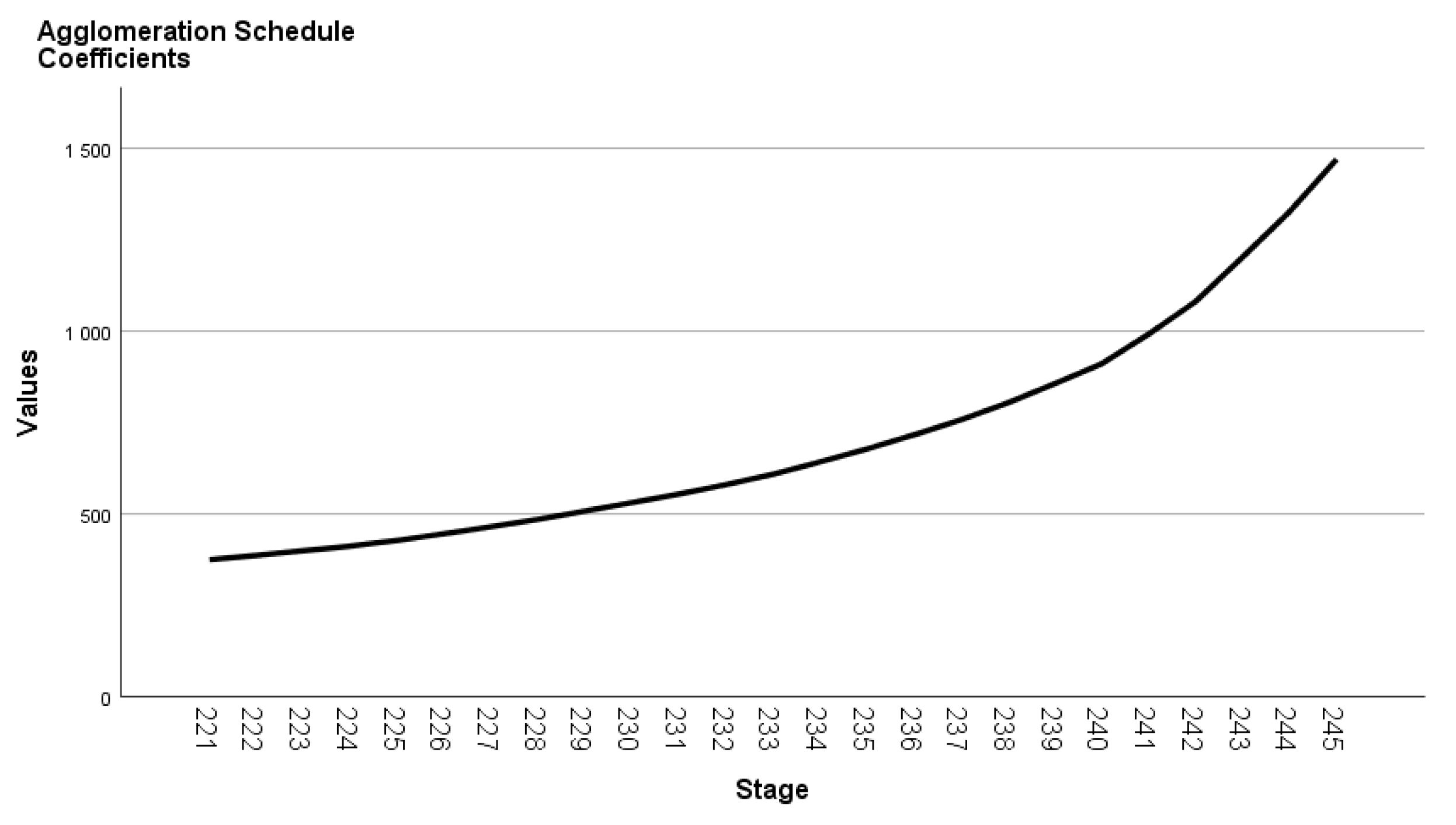
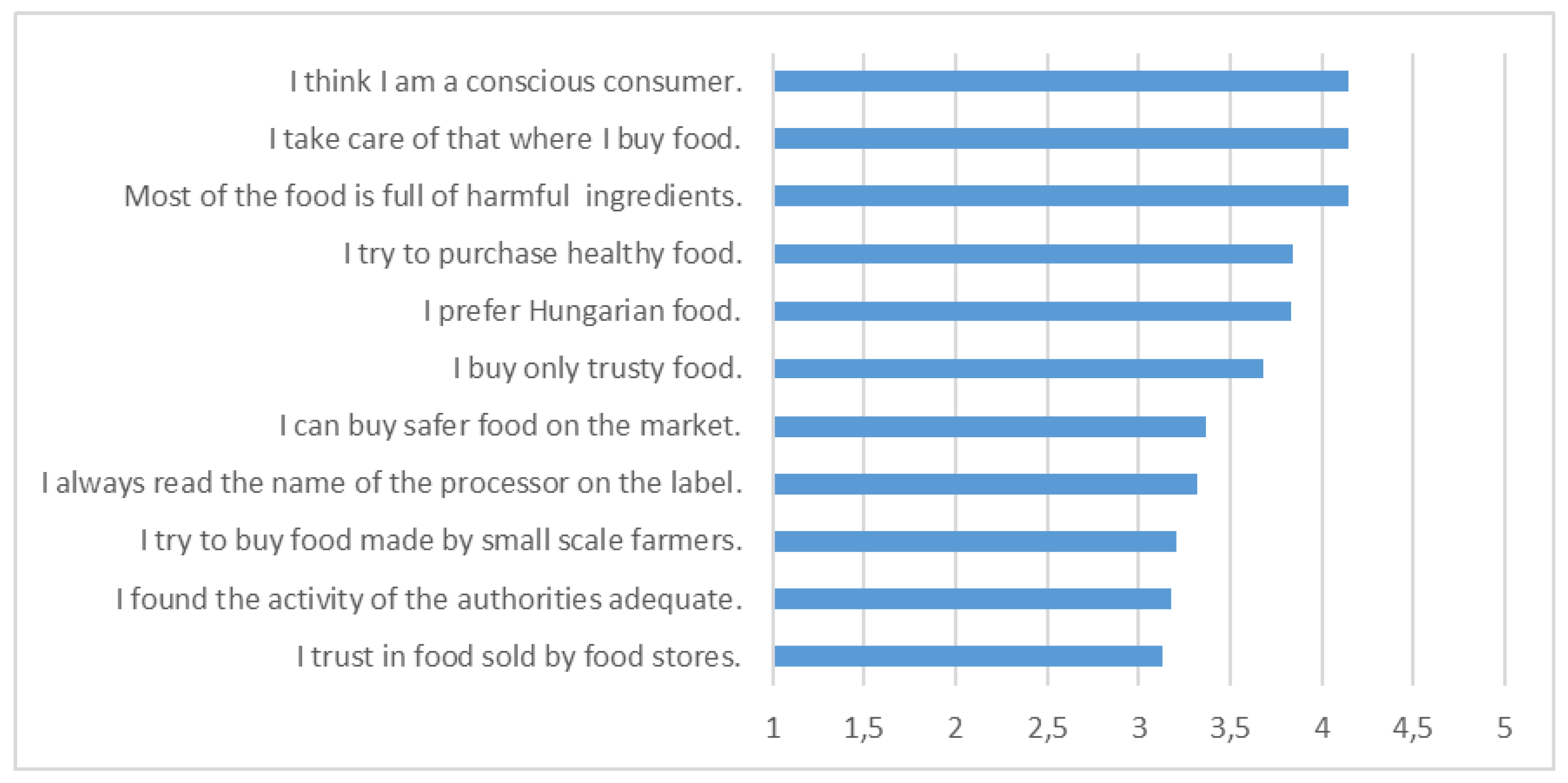

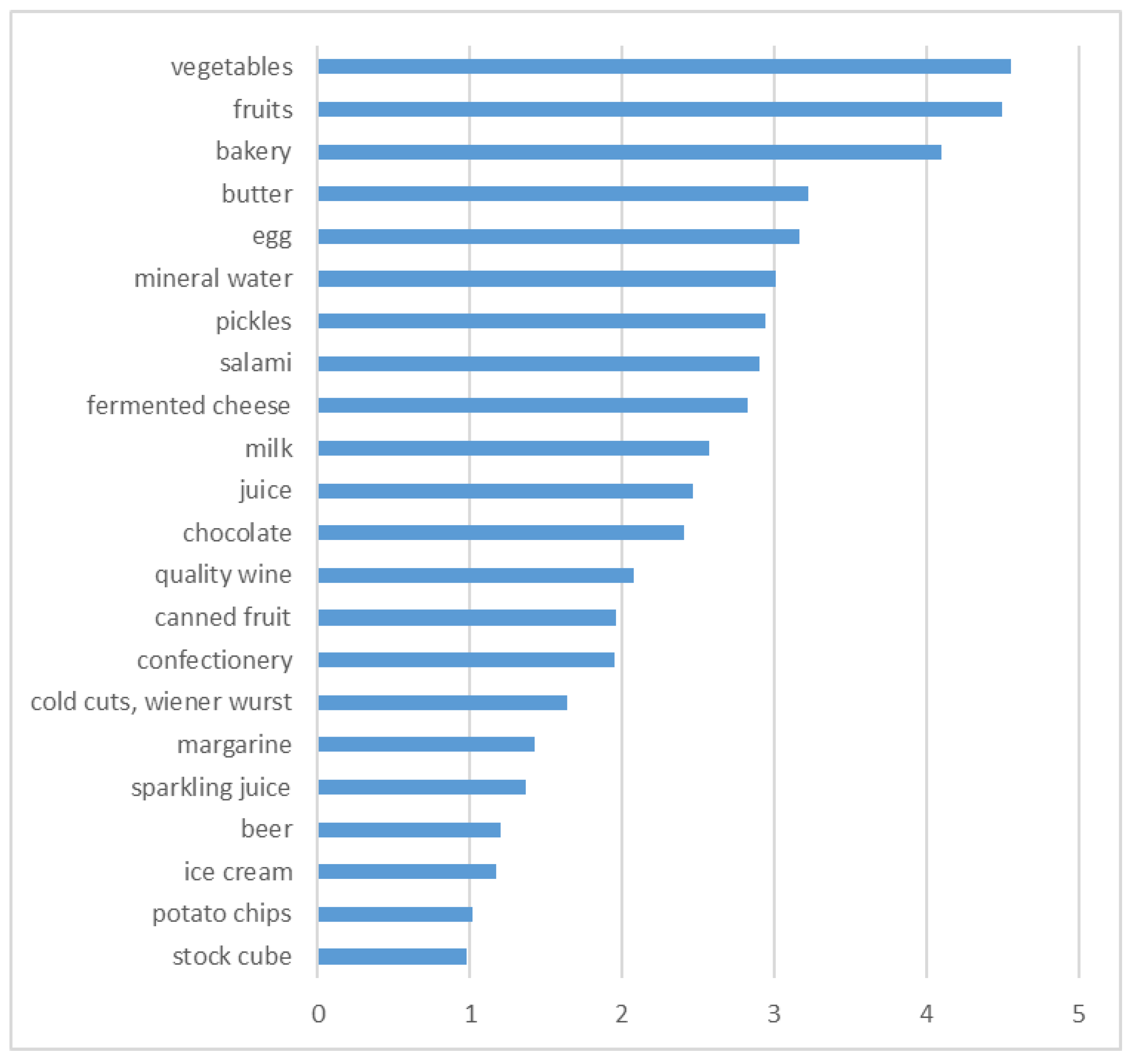
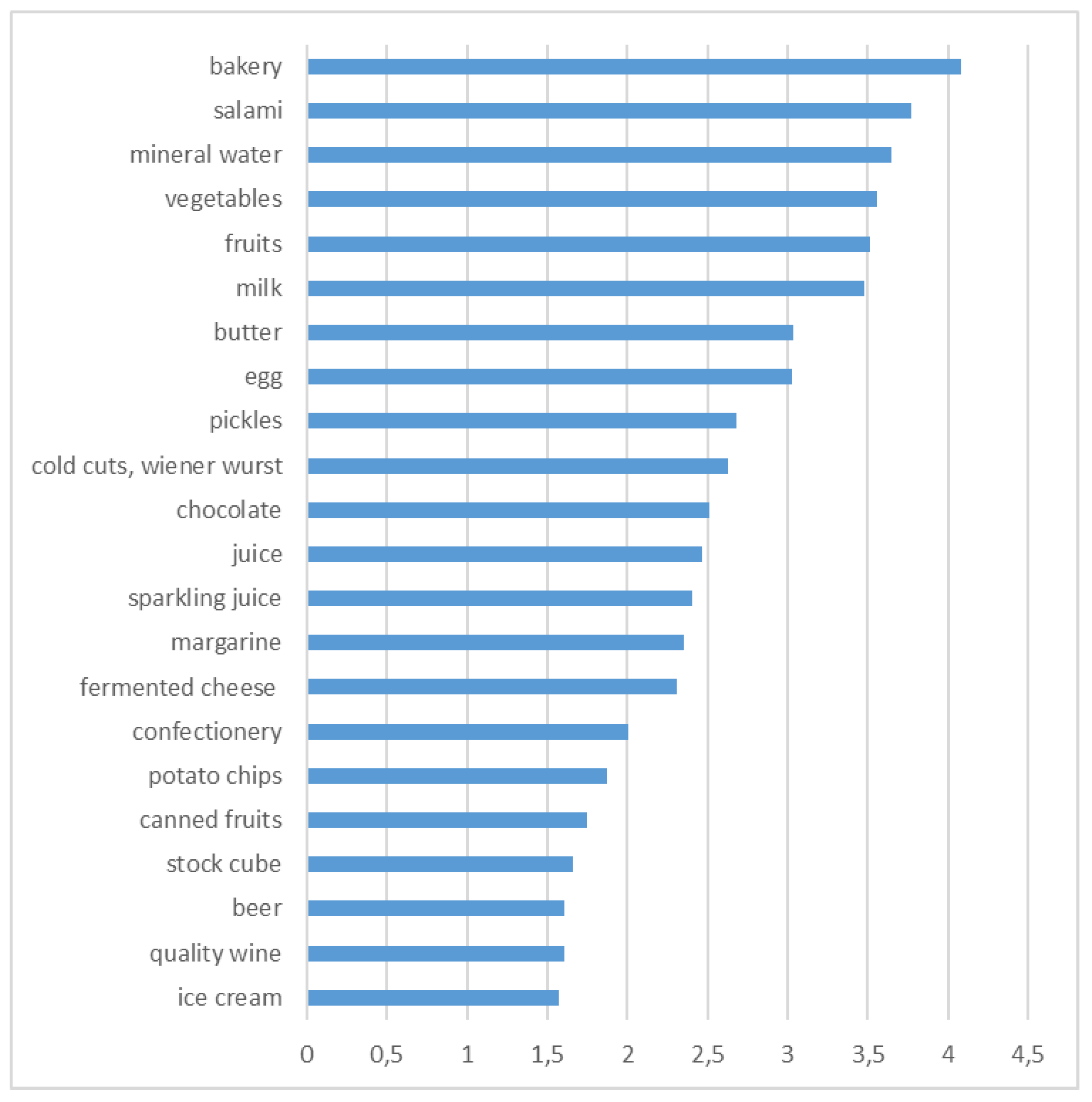
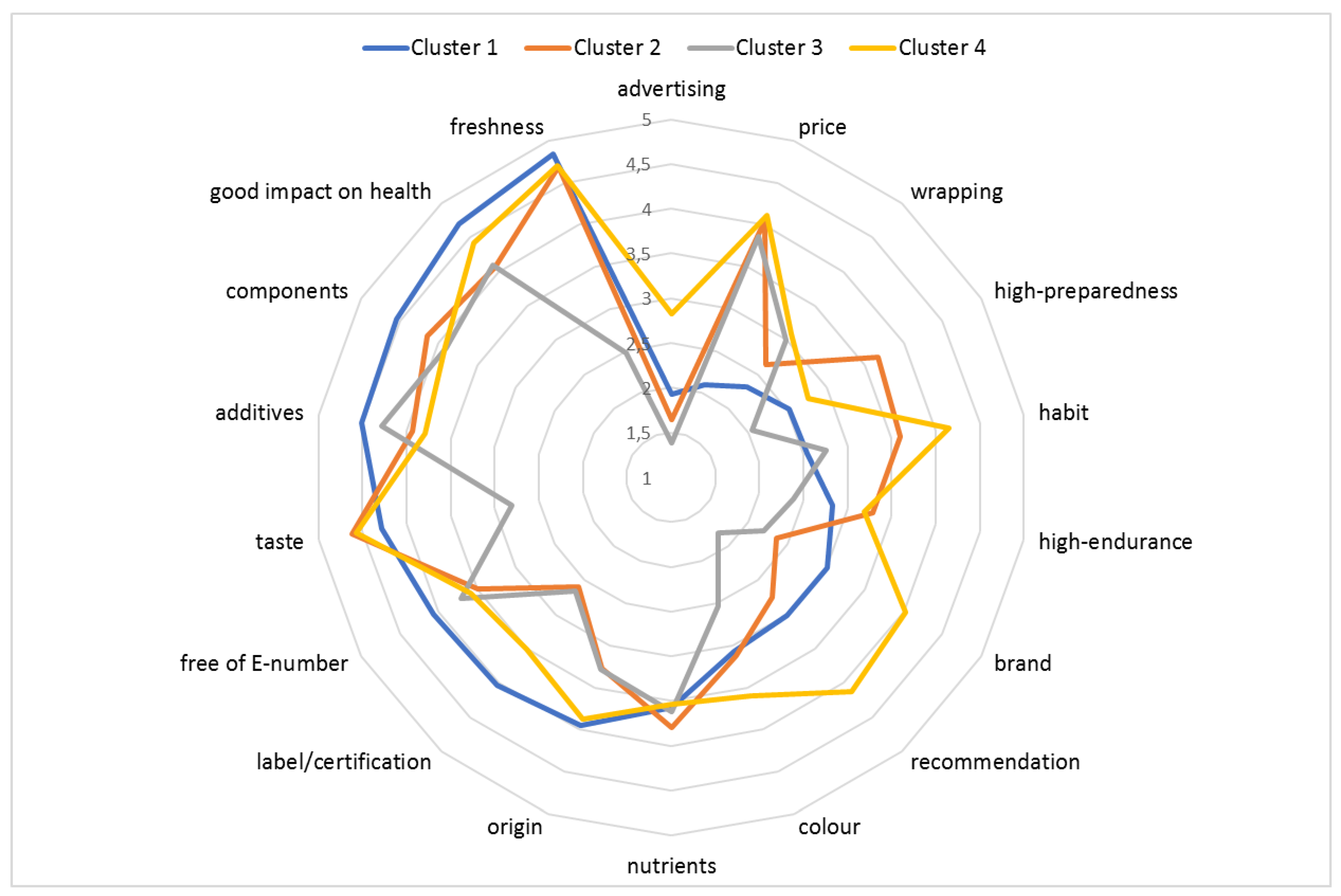
| Cluster Number of Case | REGR Factor Score 1 for Analysis 1 | REGR Factor Score 2 for Analysis 1 | REGR Factor Score 3 for Analysis 1 | REGR Factor Score 4 for Analysis 1 | REGR Factor Score 5 for Analysis 1 | REGR Factor Score 6 for Analysis 1 | |
|---|---|---|---|---|---|---|---|
| 1 | Mean | 0.3719936 | 0.0305698 | 0.2100684 | −0.3274677 | −1.2811828 | −0.2956395 |
| N | 59 | 59 | 59 | 59 | 59 | 59 | |
| Std. Deviation | 0.90315332 | 0.88929638 | 0.79562377 | 0.91567436 | 0.72484566 | 1.12373810 | |
| 2 | Mean | −0.1319210 | −0.6791270 | 0.2445502 | 0.5734791 | 0.2775804 | 0.1043713 |
| N | 88 | 88 | 88 | 88 | 88 | 88 | |
| Std. Deviation | 0.90315332 | 0.69337555 | 0.68250015 | 0.89487064 | 0.65204011 | 1.05759567 | |
| 3 | Mean | −0.1519007 | −0.5637794 | −2.2113915 | −0.5323831 | 0.4719697 | 0.0564277 |
| N | 21 | 21 | 21 | 21 | 21 | 21 | |
| Std. Deviation | 1.16376660 | 0.54495091 | 1.08128650 | 1.19386063 | 0.69237934 | 0.90991976 | |
| 4 | Mean | −0.0916494 | 0.8948581 | 0.1605740 | −0.2559682 | 0.5288633 | 0.0906803 |
| N | 78 | 78 | 78 | 78 | 78 | 78 | |
| Std. Deviation | 1.05559132 | 0.73491381 | 0.64267461 | 0.82070203 | 0.70093961 | 0.81436277 | |
| Total | Mean | 0.00000000 | 0.00000000 | 0.00000000 | 0.00000000 | 0.00000000 | 0.00000000 |
| N | 246 | 246 | 246 | 246 | 246 | 246 | |
| Std. Deviation | 1.00000000 | 1.00000000 | 1.00000000 | 1.00000000 | 1.00000000 | 1.00000000 | |
| Food Choice Motives | Mean | SD |
|---|---|---|
| price | 3.585366 | 1.215054 |
| wrapping | 2.735772 | 1.264629 |
| high-endurance | 3.069106 | 1.218606 |
| advertisement | 2.065041 | 1.126597 |
| origin | 3.626016 | 1.311789 |
| brand | 3.028455 | 1.32911 |
| label/certification | 3.239837 | 1.341412 |
| components | 4.146341 | 1.047313 |
| additives | 4.056911 | 1.012581 |
| high-preparedness | 2.971545 | 1.179417 |
| nutrients | 3.646341 | 1.110675 |
| free of E-number | 3.678862 | 1.228289 |
| taste | 4.373984 | 0.946731 |
| colour | 3.211382 | 1.30776 |
| freshness | 4.544715 | 0.83056 |
| recommendation | 3.170732 | 1.263021 |
| habit | 3.45122 | 1.263159 |
| good impact on health | 4.329268 | 0.926546 |
| Components | ||||||
|---|---|---|---|---|---|---|
| Health Effect | Influences | Organoleptic Properties | Convenience | Price and Habit | Colour | |
| Price | −0.019 | −0.014 | −0.065 | 0.132 | 0.892 | −0.020 |
| Wrapping | 0.012 | 0.437 | −0.404 | 0.433 | 0.053 | 0.138 |
| High endurance | 0.074 | 0.292 | 0.038 | 0.691 | 0.133 | −0.256 |
| Advertisement | −0.067 | 0.740 | 0.073 | 0.193 | −0.041 | 0.242 |
| Origin | 0.624 | 0.298 | 0.031 | −0.175 | 0.052 | 0.029 |
| Brand | 0.073 | 0.793 | 0.158 | 0.040 | 0.013 | 0.037 |
| Label | 0.514 | 0.385 | −0.025 | −0.232 | −0.230 | −0.178 |
| Contents | 0.710 | −0.045 | 0.100 | 0.112 | −0.078 | −0.157 |
| Additives | 0.772 | −0.199 | −0.034 | −0.059 | −0.150 | 0.190 |
| High preparedness | −0.257 | −0.107 | 0.319 | 0.679 | 0.015 | 0.183 |
| Nutrients | 0.669 | −0.054 | −0.001 | 0.247 | 0.135 | 0.184 |
| Free of E- numbers | 0.814 | −0.083 | −0.065 | −0.109 | −0.048 | 0.137 |
| Taste | 0.047 | 0.124 | 0.719 | 0.140 | 0.107 | 0.330 |
| Colour | 0.117 | 0.255 | 0.131 | −0.036 | −0.013 | 0.843 |
| Freshness | 0.187 | 0.146 | 0.759 | 0.130 | −0.139 | −0.069 |
| Recommendation | −0.055 | 0.591 | 0.497 | −0.075 | 0.272 | 0.029 |
| Habit | −0.288 | 0.153 | 0.453 | −0.046 | 0.506 | 0.028 |
| Good impact on health | 0.656 | 0.134 | 0.099 | −0.092 | −0.060 | −0.101 |
© 2019 by the authors. Licensee MDPI, Basel, Switzerland. This article is an open access article distributed under the terms and conditions of the Creative Commons Attribution (CC BY) license (http://creativecommons.org/licenses/by/4.0/).
Share and Cite
Nagy-Pércsi, K.; Fogarassy, C. Important Influencing and Decision Factors in Organic Food Purchasing in Hungary. Sustainability 2019, 11, 6075. https://doi.org/10.3390/su11216075
Nagy-Pércsi K, Fogarassy C. Important Influencing and Decision Factors in Organic Food Purchasing in Hungary. Sustainability. 2019; 11(21):6075. https://doi.org/10.3390/su11216075
Chicago/Turabian StyleNagy-Pércsi, Kinga, and Csaba Fogarassy. 2019. "Important Influencing and Decision Factors in Organic Food Purchasing in Hungary" Sustainability 11, no. 21: 6075. https://doi.org/10.3390/su11216075
APA StyleNagy-Pércsi, K., & Fogarassy, C. (2019). Important Influencing and Decision Factors in Organic Food Purchasing in Hungary. Sustainability, 11(21), 6075. https://doi.org/10.3390/su11216075






